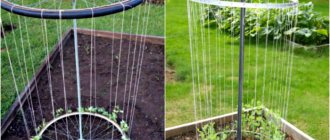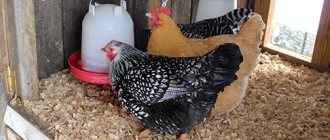The industry takes care of gardeners and gardeners and creates more and more new tools to help us. The only sad thing is that the price for them is not always affordable for farming enthusiasts. However, many work equipment can be made with your own hands.
To create the proposed tools you will need a minimum of materials and tools. Their sizes may vary, depending on your needs and preferences. Such devices will help when carrying out the most common garden work: sowing and loosening.
Rammer
If you want to get a good harvest (and this is the dream of all summer residents), you need to start with the correct sowing of seeds. The basis for good growth is a strong root system. Its health depends precisely on how you carried out the sowing. To ensure a strong root system, seeds must be sown on compacted soil. For this purpose, a tamper is useful, which you can easily make with your own hands.
In design, it resembles a regular wooden mop for washing floors. The only difference is in the lower part: for a mop this part is flat, but for a rammer it should be semicircular, resembling a rolling pin or handle cut lengthwise.
To work, you will need a wooden handle, a semicircular board for the bottom, 2 small parts for stops and several screws to connect the main elements.
Mark a row and compact the soil along its entire length with a hand-made tool, and then begin sowing.
Weed fork
This device will become indispensable in your garden, greenhouse, flower bed, vegetable garden and lawn. As a result of using the fork, the loss of spoilage to other plants is minimal. Using this tool, you can easily eliminate weeds with a long root system. And the curved metal nozzle allows you to increase the pressure on the tool handle. The device is very easy to use, very light and compact, reliable, and provides good results. The fork will help get rid of weeds even in minimal soil space and in hard-to-reach areas.
We advise you to read: Which tool is best for dealing with weeds on the site
Single-row marker seeder
To speed up the sowing process, you can build a single-row marker. It is made from a small wooden block and wine corks, which are connected using self-tapping screws. The distance between the plugs depends on what crop you will use this seeder for. For beets or onion sets, screw the plugs at a distance of 10 cm from each other, for peas or carrots - at intervals of approximately 6 cm, etc.
On the prepared bed, mark the rows and go over them with a marker. Now all that remains is to water the resulting holes and place the seeds in them. Sowing time will be significantly reduced because you will not have to drill each hole separately.
Root remover
The root remover blade allows you to easily remove weeds in narrow places, in beds and in the area between rows. The device is equipped with a comfortable handle and a working part in the form of a narrow, light spatula. There is also a manual type root remover. it is often called a screwdriver, since the shape of the tool is very similar to it. The garden root remover has a durable wooden handle and a sharp metal tip. This type of root remover is designed for mechanical cleaning of the soil from weeds during dense plantings. It is very easy to use. The root remover should be immersed in the soil next to the weed and, tilting the tool, lightly pull the plant out of the soil.
Hoe-ripper
Any gardener knows: there can never be too many hoes. We suggest you make a comfortable hoe-hoe with your own hands. To make it, you will need a small piece of board and nails 6-10 cm long (the depth of loosening the soil depends on the length of the nails).
Make a wooden handle of the size and shape that suits you. Sand it thoroughly with sandpaper to avoid splinters getting into your palm. Drive several nails around the perimeter of the thickened part at a distance of about 1.5 cm from each other.
To prevent the board from cracking when driving a nail, use a little trick from experienced craftsmen. Before you begin, use a hammer to flatten (i.e. flatten) the ends of all nails. In this case, when hammered, they will not split the wood fibers, but simply crush them - and cracks will not form.
Such a small hoe-hoe can help you out when weeding small flower beds or narrow row spacing in vegetable beds.
Minimum Required
Every gardener must have this set. If any of the tools are missing, then the shortage will certainly be acute.
Shovels
The farm must have at least two types of shovels.
- Bayonet - will help you plant potatoes, dig up bushes, and perform many other operations. You will have to look for a shovel suitable for a specific soil: for clayey and heavy soil, a rounded blade is suitable, and for sandy soil, a tool with a straight edge is suitable.
- Scoop - resembles a scoop, only larger in size and with a long handle. It will come in handy when you need to collect small debris or pour sand into holes.
You cannot skimp on these agricultural implements. It is advisable to buy reliable tools made of rail or stainless steel. Titanium products are good. The cutting should be taken from wood or metal.
Garden scoop
A mini-spatula will be needed when transplanting seedlings and to make holes. If you are working with small seedlings, then a small scoop will be useful, but for trees and shrubs it is better to buy a larger spatula, for example, a sapper one.
Please note that the design of the scoop may differ: wide and narrow, short and long, with a cutting edge or a perforated blade. For the main part of the functions, a regular spatula with a rounded edge and medium blade width is suitable. Start with her.
Rake
They are useful for collecting leaves and tops, as well as for breaking up lumps, making beds and leveling the ground. The teeth can be straight or twisted. The former are suitable for cleaning, and with the help of the latter it is convenient to loosen the soil.
To rake fallen leaves or grass, use a fan rake. They have a reduced gap between the teeth, which makes things go faster. In addition, the equipment itself weighs less, which means a person will not get so tired.
Hoe
For weeding, loosening and hilling, it is worth getting a rag. We list the most popular varieties.
- Garden hoe - characterized by a wide blade located at a right angle relative to the handle. It is useful for any task, but works best in the fight against weeds.
- A hoe or hoe (pictured) is distinguished by a semicircular pointed edge. Designed for removing grass and creating holes for planting.
Pitchfork
They are needed to stack hay and remove tops, dig up hard ground, and in some cases even collect vegetables that are usually dug up with a shovel. It all depends on the form.
Digging forks have straight teeth that can be faceted, round or flat. Digging forks with rubber tips are used to harvest potatoes. The harvesting ones are much lighter and thinner, and the manure ones have curved teeth like a bucket.
Secateurs
Designed for trimming tree branches of small diameter and cutting flowers. There are bypass and persistent. If you have a large garden, then it is advisable to choose both types of pruners.
Bypass options are equipped with two different blades: one of them has a notch, and the other is convex. This device is good for cutting young shoots.
It is better to remove dry branches with persistent pruners. It has only one blade on top, and the lower part serves as a stop.
Axe
A multifunctional and very necessary tool: cutting down a tree, hammering a peg or chopping wood.
It is preferable to take a weapon with a handle made of wood or carbon fiber, since they are lighter than metal ones and fit more comfortably in the palm. For the main part, steel is used, the quality of which can be checked by simply clicking on the metal with your finger: the sound must be ringing and slowly decaying.
Knife
This device is in every home, but for the vegetable garden it is advisable to have a separate one. It should be medium in size, with a comfortable handle and a sharp edge.
Using a knife, it is convenient to cut ripe fruits without damaging the stem, uproot the roots of a weed, or clear vegetation from the seams between the tiles of the paths.
Unusual weeding device
Pay attention to another device that can hardly be called a hoe, although it performs the same function - it removes weeds. To make such a device you will need wood for the handle and thick wire for the working part. For it, you can take, for example, nichrome wire with a diameter of 4 mm or any other durable material.
Cut a handle from a wooden blank. In its upper part, drill one through hole, equal in diameter to the wire. From the hole on both sides there should be 2 grooves measuring 2-3 mm, in which the working part will subsequently need to be slightly “recessed”.
Bend the frame from the wire using pliers. Insert it into the cut hole and clamp it in a vice. You can secure the frame in the handle by wrapping it with soft wire or a bandage soaked in PVA glue. When the glue dries, the tool is ready for use.
Do-it-yourself gardening and gardening tools
Do-it-yourself gardening and gardening tools
The garden and vegetable garden are a special place where we grow delicious, and most importantly healthy vegetables and fruits. Of course, to care for your favorite vegetables, garden crops and flowers in a beautiful flower bed, you need a lot of different tools. It happens that it is simply not possible garden tool For example, the dacha is located far from home or you live in a rural area and it is simply unrealistic to simply go and quickly buy an instrument.
In this case, excellent homemade garden tools . You don’t need to invent anything, everything was invented long ago by quick-witted and savvy gardeners and gardeners. All this is very easy to do, often you just need old tools that are no longer used, and it’s always a shame to throw them away! Let's start exploring homemade equipment!
Making equipment for your site yourself is always very profitable and economical. And besides the benefits, it also brings a lot of pleasure when using something that you made yourself, and was not sold to you by a salesperson in a store. I’ll tell you even more, there are a lot of equipment invented by folk craftsmen with ingenuity that are simply unrealistic to buy in a store; many folk inventions don’t even have analogues in stores and markets.
Shovel against weeds. We remove weeds with a new shovel
Weed Shovel
Tormented by growth? Is it not convenient to remove it with a shovel? Can't cut it out with a hoe? And the ax doesn't fit? The solution has been found! You need an old shovel.
If you have a shovel in your shed that is no longer suitable for digging, you can use it to make a new tool to make it easier for you to cut down the undergrowth. Such a shovel will go deep into the ground and cut it out at the root, so to speak. It penetrates the ground without much effort and cuts the growth just as easily; using such a tool will be easy even for those who do not have much physical strength.
So, take your old shovel, grinder and head to the vice, or find a replacement for it. For convenience, you can remove the holder.
- Now cut 6 centimeters in both directions from the center of the shovel blade, the width of the tool will ultimately be 12 centimeters, cut the shovel evenly, you will just get a narrow shovel.
- Now measure down from the top edge 26 centimeters and trim the shovel evenly.
- Next, measure 13 centimeters from one side, place a dot and draw a straight line from this point to the opposite lower corner.
- Now cut the iron obliquely along this line.
- Then sharpen the edge of the shovel until it is sharp.
- Place a homemade weed shovel on the cutting.
The tool is ready!
Shovel with teeth for digging
Shovel with teeth
Another folk tool for working in the garden. Such a shovel is simply the ideal tool if you decide that your garden or vegetable garden is not enough and it’s time to expand it. She digs well and easily. When expanding a site, we often climb into territory where, of course, something had previously grown, and of course there are roots there.
When digging with an ordinary shovel, we usually just crash into them and then a long digging begins to get to this ill-fated root, which during digging will pull all the nerves out of you, you have to dig it up, then pull it out, which is not easy.
Such a shovel with teeth will save your strength and nervous system, it will easily cut these roots into pieces and will not make it difficult to dig up a new area where you can safely plant something else that is very necessary and useful for you.
So, we take a shovel, if you don’t mind, a new one will do, but the one with which it is no longer possible to dig, but you don’t have the courage to throw it away, will do. We take the grinder and go to the vice or replace it.
- Trim it so that there is no part of it that you usually dig with, in general, you just need to make an even shovel.
- Then draw teeth on it, correctly calculating their size. Usually 4 cloves are made. They are made according to the principle that at the edges you have, as it were, half a tooth, and in the center there are 2 whole ones.
- Cut and sharpen the teeth well.
Your instrument is ready! Feel free to dig up new lands without being afraid of the roots.
Do-it-yourself miracle chopper
Do-it-yourself miracle chopper
Every gardener and gardener always uses the most ordinary hoe. Have you ever thought that using something like this brought you some inconvenience? If yes, then this is the hoe you need.
This is an unusual homemade hoe, which is convenient for not only weeding, but also very convenient for making furrows for planting. It’s easier to make one like this, and the benefits come in a ton.
In order to make it, you will only need a piece of iron, a piece of metal pipe or part of an old hoe (where the handle was inserted), a grinder saw and welding, there is no way without welding.
To make it easier to understand what you have to cut out of iron, first sketch out a sketch on paper.
- Take a piece of iron 24 cm long and 12 cm wide.
- Now you need to draw it out so you can cut it later. Determine the center along the length on one side, put a point.
- Measure 2 cm from the center in both directions, mark with dots as well.
- Now from these points down measure 4 cm on each side.
- Connect the resulting dots. You will get a square 4 by 4 cm.
- Determine the center of that drawn square and place a dot in the center.
- Take a pipe that will become a tip for attaching the handle. Place the pipe approximately in the center of the outlined square. Trace the pipe to determine where you will cut the hole for the pipe.
- Now let's continue drawing. Apply a ruler from the bottom corner of the already drawn square to the corner of the iron and draw an oblique line. Do the same with the opposite corners of the square, drawing a line to the opposite corner of the iron sheet. You should now have a trapezoid.
- Now use a grinder to cut the metal along the drawn lines. Cut a trapezoid and a square on top along the contours, without separating them.
- Cut a circle for the pipe in the top square.
- Trim the hoe itself again so that it acquires a rounded shape, including the corners. That is, round the bottom of the trapezoid.
- Next, bend exactly the square into which the pipe will fit. Fold along the line that separates the square from the trapezoid.
- Place a piece of iron in the form of a trapezoid (the hoe itself) on the pipe and, using a regular hammer, bend it so that it becomes round.
- Then insert a piece of pipe into the cut hole, which will attach the hoe to the handle of the hoe.
- Weld the pipe to the hoe using welding.
Sharpen the hoe well, as you always do with a regular hoe.
And now your new hoe is ready!
DIY soil ripper
Soil ripper
Has it ever happened to you that you need to loosen the soil under a plant, but it’s not convenient to use a hoe or other tool? Or do you sometimes need to loosen under a bush and it’s also inconvenient to crawl with a large tool?
It happens that a tool can damage the roots of a plant, but loosening the top part is simply necessary. Well, don’t do it with a fork like in a potted pot!
The solution has been found! The set for this device is simple and cheap. To prepare this miracle equipment you only need nothing. All you need is large nails and a piece of board.
- Take a board and draw on it something like a massage hair brush, but of course bigger. Ideally, the length of the instrument is 25 centimeters, the head of the instrument is 8 centimeters in diameter. But you choose your own size according to your requirements.
- Cut out this blank with a jigsaw.
- Now take 5-8 nails no shorter than 6 cm, you can even use slate nails, they can be trimmed if they are long. And now you just hammer them along the edge of this “brush”.
Your ripper is ready to use!
We repair secateurs. If the pruning shears have a broken spring
Secateur repair
Every gardener has a pruning shear in their toolbox. As we know these days, the tool leaves much to be desired, but those old Soviet pruners are what we need and many people use them. But often use becomes impossible and always for one reason: spring breakage. And without a spring, of course, further use of the pruning shears is a big problem.
But it is very possible to solve this problem. A piece of thick rubber will be your savior.
- You need to cut a strip of rubber so that it is enough to cover the entire inside of the handle. It should lie from the beginning of the handle and pass continuously to the end of the second handle. Try squeezing the handles, the rubber should spring back well, if not enough, take another strip and twist the two strips.
- Secure the rubber along the entire length of the handles. Do this well by wrapping the rubber handles with electrical tape. This way it will be securely fastened and you will avoid possible injury.
If your pruning shears are dull, you can sharpen them with a regular knife sharpening stone.
The pruning shears are ready to use again!
Device for cutting branches at height
Devices for cutting branches at height
There is always a branch on any tree that needs to be cut down, but it happens that it is so high that cutting it down is a problem. You can, of course, set up a ladder or climb a tree, but this is not always accessible, and certainly not everyone can climb trees. But a folk remedy has been found that helps cut any branches in any hard-to-reach places without stairs or dangerous tree climbing.
The device is very simple, you only need an ordinary hacksaw that lies in your garage or shed and a long stick.
Now take a hacksaw and a stick, only a strong one, and combine them into a single tool. It is best to tape the handle of the hacksaw to a stick with electrical tape; you can also wrap it firmly with wire, but then it is just as difficult to unwind it back, and then you can simply cut the electrical tape and that’s it.
Grab a stick and start sawing an unnecessary branch. But just protect yourself with glasses so that small sawdust does not get into your eyes and you do not get an eye injury.
The device for cutting branches is ready!
Device for picking apples and pears
Device for picking apples and pears
It often happens that there are still tasty and appetizing apples, pears, or even cream on the branches, but it is not possible to get them. The stairs are not comfortable, and climbing a tree is dangerous.
In such cases, devices for collecting fruit from trees come to the rescue. Of course, such a device can be bought at any store.
But what to do if you are already at the dacha, or you are in your own garden near the house, and you really want to pick these fruits, but they are so high? Surely you have at least one plastic bottle, and you will definitely have a stick or a plastic pipe.
- Take a plastic bottle, it is best to use a 2 liter bottle, in case you have large apples.
- Step back a couple of centimeters from the bottom, make an oval hole, don’t make it too big, it’s still plastic and if it suddenly turns out to be too small, you can easily enlarge it.
- On the four sides of the hole you need to make keyhole-shaped slits.
- Next, place the neck on a long stick or plastic pipe. It’s better to fix the neck; it’s best to just take and hammer in a small nail, which you can then pull out if you need to remove it.
Using such a device is easier than making it, you just need to lift it to the desired fruit, lower the fruit into the bottle, lower or lift it so that the tail falls into the slot hole and just pick the fruit, it will be inside the bottle, and you can easily get it out of there.
The tool is ready, use it to your health!
Weed removal loop
Weed removal loop
Removing weeds is a must; a good crop will not grow in weeds. Have you ever been unable to remove a weed with a hoe because the distance between the cultivated plants and the weed is small and there is a risk of damaging it? Surely this happens to every gardener, gardener, and especially to everyone who grows flowers.
The so-called weed removal loop will solve your problem, with its help you can easily remove weeds or even just an unnecessary plant, where there is very little space, you don’t want to tear it with your hands or for some reason you can’t do it with your hands, sometimes you have a completely sore back doesn't allow you to bend down and do it manually, but the tool will save you.
In order to make such equipment you don’t need much at all. Only a piece of iron and a handle or handle from a shovel.
- Take a piece of iron and cut a strip 20-25 centimeters long and 5-7 centimeters wide.
- Now bend this iron into an oval shape using a hammer on something suitable in shape. You will get an iron loop.
- Now take the handle, you can use it from another tool that is no longer suitable, but do not take it too light, otherwise it will be difficult to remove the weed.
- Next, nail to the handle with a pair of nails, first one side of the iron loop, then the second, respectively, from the other side with a pair of nails.
- Next, you need to sharpen the metal on the loop well on one or both sides, depending on your wishes, whichever is more convenient for you. If you need to bend it more or, on the contrary, make it wider, then look at your requirements for the tool.
Your weed loop is ready to use!
Making convenient and cheap garden equipment with your own hands is not at all difficult and does not put a strain on the family budget. Using our instructions, you can easily give many tools a new useful life.
Let your areas always be well-groomed!
Garden trowel
You can't do without a shovel in a dacha business. We suggest you make a small garden shovel, which will be very convenient, for example, to pick up soil when sowing seedlings or planting flowers in containers.
For work, prepare a galvanized pipe with a diameter of 3-5 cm (the size of the blade depends on your needs). Mark the middle on it. At this point, cut the pipe crosswise, cutting through about half. Now one of the parts needs to be cut lengthwise and the edges bent outward.
Draw the outline of the future shoulder blade on the bent part. Using tin scissors, cut them according to the design. Sand the blade well and wrap the handle with electrical tape. Now you can get to work.
Fokina flat cutter
It is a flat wooden stick with an attachment in the form of a metal hoe. The metal structure has an irregular curved shape. Thanks to their thin curves, the plates not only effectively eliminate weeds during weeding, but also help to hill up and loosen the soil.
With the help of a flat cutter it is easy to carry out other garden work. The device comes with several attachments. They are suitable for fine work with weeds and soil cultivation. This tool is very popular among gardeners and gardeners.
MOST READ FROM PARTNERS
Knife for removing whiskers from strawberries or grapes
It is not always possible to easily trim the tendrils or young green stems of grapes or strawberries with an ordinary knife or pruning shears. A special knife is suitable for this purpose. Its steel blade has a pointed shape and resembles a leaf. An unusual detail is a hook-shaped recess made on one side of the blade. It is this place - from the inner surface of the blade - that is sharpened.
To trim an annoying mustache, take it in your left hand, and lightly run the sharp part along it with your right hand - the unnecessary shoot will be immediately removed.
These simple tools will help you make gardening and gardening more comfortable.
How to choose a garden tool
The easiest way, of course, is to purchase a garden kit that includes everything you need. These kits may consist of gloves, a spatula, pruning shears and a jug. Such a set will be useful both for an amateur and for a person who is completely devoted to the garden or vegetable garden.
Ready-made kits will also be quite useful for buyers who are poorly versed in such topics or simply those who have just started growing crops.
Method of growing potatoes without weeding
Particularly radical adherents of green farming argue that potatoes should not be weeded at all without damaging the future harvest. At the same time, this method was invented back in the 19th century and is actively used by some agronomists. This method also involves weed control, but it comes in a different form.
To grow potatoes without weeding, the soil is prepared in the fall. To do this, it should be cleared of weeds in advance, dug up or plowed, but without loosening, so that the soil can breathe better. After this, humus mixed with ash, urea, nitrogen and potassium fertilizers, which are destructive to Colorado potato beetles and other pests, is added to the soil. The top of the area is covered with a thick layer of straw.
During the autumn-winter, the straw will rot, preventing pests and weeds from penetrating the soil, forming a layer of natural mulch. Sprouted potatoes are planted without removing this mulch, fertilizing the holes with pre-prepared humus.
After germination, a layer of mulch prevents the appearance of weeds, maintains a favorable soil temperature and retains moisture.
Important! Instead of straw, you can use green manure (alfalfa, rapeseed, peas and other legumes), which are sown in advance in August. By September-October they form a fairly tall grass cover, which is mowed for the winter
Thus, mulch is obtained from hay grown in the same area.
Thus, weeding potatoes is an integral part of agricultural technology for growing potatoes, although there are growing methods that do not involve weeding. There are also many devices for weeding potatoes - from traditional manual ones to mechanized ones. Undoubtedly, the use of modern mechanized tools greatly facilitates and speeds up the process of weeding potatoes.
Mini rake
The tool quickly, accurately and effectively removes weeds with very deep roots. The device has sharp steel teeth that penetrate very deeply into the soil and efficiently capture the root system from all sides. No special physical effort is required. The movements when using a rake are very simple. First you need to immerse the tool in the soil near the weed, then turn it one hundred and eighty degrees and easily remove the plant. After this, the weed is removed using a special attachment. This type of weed control tool will help to carefully remove weeds from the lawn, including plants with deep roots - dandelions, cereals.
The best option for controlling weeds is complex treatment of the affected areas of the soil. Each weed control device has its own individual function. Depending on the need, select tools with a specific action and functionality. Any of the tools presented can be an ideal solution for weeding, clearing weeds from the lawn and cultivating the soil.
For extreme sports enthusiasts
This very exotic method of killing weeds was invented here in Russia. It is used to treat beds on which vegetable crops that are difficult to germinate are sown, for example, carrots, parsley, dill. In such beds, weeds sprout much earlier than the cultivated plants hatch. Russian summer residents have invented an extreme method of exterminating weeds - they literally burn them with fire. This is done using a blowtorch. You need to move along the bed, treating its surface with a sliding flame. This is done quickly, the key word is a sliding flame. If you leave the fire in one place, the seeds of the sown vegetables will also burn out. After fire treatment of the soil has been carried out, it is recommended to cool the bed by regular watering.
Weeding trimmer attachments
For work, it is recommended to use a factory-made cultivator attachment. This is both easier and cheaper than making the device yourself. When selecting, it is recommended that you first take your trimmer and measure:
- rod diameter;
- number of splines on the shaft.
This information will allow you to choose the right nozzle. Typically, the description of the nozzles indicates the outer diameter of the rod - 26 or 28 mm and the number of splines on the shaft - 7, 9, or the cross-sectional shape of the end - square. To accurately select the right size, you should also measure the diameter of the shaft itself - they also differ in size, there are shafts with a diameter of 7, 8 and 9 mm.
If you are using a branded tool from well-known world brands, and not Chinese consumer goods, then it is better to order a branded attachment. This will extend the life of both the attachment and the brush cutter. In Moscow, for example, it is worth visiting branded stores, where professionals will select the nozzle; here you can also consult on the procedure for servicing the units.
To work on small areas, a regular disc cutter will be sufficient, but for large areas it is better to use reciprocating and drum cutters.
It is recommended to sharpen the cutters before each use.
When selecting a working tool, you need to focus on the dimensions recommended by the manufacturers. The hand will not be able to hold the blades that are too large, and the blades that are too small will not cope with the task. If you can select several sets of cutters for a cultivator, then you should consider purchasing cutters of different diameters - this will allow you to choose a tool for each specific type of task.
Test or how to use
Weeding is faster and easier
The entire load falls on the wheel and hoe. Weeds are removed by forward movements of the device. If cutting the roots of the weeds did not work with the first movement, then repeat it and move a little forward and continue cutting the weeds.
Pruning is easier than loosening and removing weeds by the roots. The pruning method allows you to move between rows and cut off new weed formations in a short time. It is recommended to walk once or twice a week - this is a walk without much effort.
How to make a wheel hoe
Device for effective weeding
10 Total Score
Device for effective weeding
Did our article help you?
10
How to get rid of weeds on the site: 10 folk remedies
It’s unlikely that anyone will argue that one of the most labor-intensive jobs in the country is weed control. You just spend a lot of time and effort trying to get them out before they come back again. However, there are ways that make this work easier and get rid of weeds on the site.
1. Carefully dig up the area. This is not an easy job, because it is not enough to just dig up the ground - you also need to carefully select all the rhizomes from it. But this is a very effective way to combat perennial weeds - wheatgrass, sow thistle, sowweed and dandelions. 2. Treat with herbicides. This method has a lot of opponents, because chemistry is not useful for the environment. But if you have a large plot overgrown with perennial rhizomatous weeds, and the soil is very hard, you won’t be able to cope with it with just one shovel. This is where continuous herbicides come in handy. The choice is quite large: “Hurricane Forte”, “Arsenal”, “Tornado”, “Roundup”, “Growd Bio”. As a rule, they help the first time, but if suddenly they don’t work, repeat the treatment and increase the dose (half more than indicated in the instructions). The exception is Sosnovsky's hogweed. They have no effect on him, just dig around. 3. Cover the ground with roofing felt or black non-woven fabric. The essence of this method is simple - weeds, like other plants, need light. There is no light - they die. It is more convenient to use - it is dense and will not be blown away by the wind. But this is chemistry. Black non-woven is environmentally friendly, but it is quite thin - it will have to be securely fixed to the soil surface, for example, pressed with boards or bricks. However, you can use other available materials - plywood, cardboard, pieces of iron. The appearance of the area covered with opaque material is very unsightly, and it must be kept in this form for the entire season. But the method is very effective even against perennial weeds.
4. Sow green manure. Look at the nearest meadow - only short grasses live there. Have you seen an abandoned summer cottage? These have gigantic, sometimes two-meter-high weeds in full growth. They are adapted to live on empty land; other plants are competitors for them. And to prevent them from settling on your site, do not leave the land empty. After harvesting, sow the ground with green manure - rye, rapeseed or mustard. Mustard completely clears the earth of weeds and diseases. In the fall, green manure should be cut and dug up - it is also an excellent fertilizer. 5. Mulch between rows. An excellent option is to spread mowed grass left over, for example, from a lawn, among the cultivated plants. But it must be laid in a thick layer of at least 5 cm - weeds will not be able to grow through such mulch.
The soil around useful plants can be covered with the same weeded weeds (only without seeds!), mowed grass, sawdust, rotted hay or straw.
You can cover the ground with film, cardboard - almost any materials that prevent the penetration of light to the soil and impede the growth of plants. But organic materials are still better. They not only prevent new weeds from germinating, but also supply the soil with nutrients, gradually turning into humus. The layer of organic mulch must be renewed all the time. 6. Use compacted crops. The principle here is the same as with green manure - the land should not be empty. For example, you can sow radishes between cucumbers. And next to the tomatoes and peppers is basil. 7. Do not apply fresh manure . It contains a huge amount of weed seeds! Put it in a pile and let it rot for at least a year. When decomposed, this fertilizer becomes very hot and the seeds in it die.
8. Digging beds with a pitchfork. This will prevent you from cutting the rhizomes of perennial weeds. And you can definitely do it with a shovel. And the more small pieces remain in the soil, the more weeds will grow next year. 9. Pull weeds with your hands rather than cutting them down with a hoe. Many harmful herbs, for example, acorn grass, are able to grow from the upper part of the root - they have dormant buds there. And as a result, instead of one thin weed, you grow a branchy bush with several stems, on which many more seeds ripen. If you don’t keep track, they will all crumble into the soil and clog up your area with terrible force. 10. Use drip irrigation. If water gets directly to the roots of cultivated plants, the weeds in the rows will die from lack of moisture - after all, they also need to drink. As a last resort, water from a watering can without a sprayer under the root - slowly so that the water does not spread. But you shouldn’t spray the entire area with a hose - this is the simplest thing you can think of, but this method of watering provokes the growth of weeds.
ACTUAL NEWS
MOST READ FROM PARTNERS
MOST READ FROM PARTNERS
MOST READ FROM PARTNERS
You may also find the following materials useful:
- Treatment of apple trees in the spring against diseases and pests: what to treat, preparations
- Natural enemies of aphids, or 13 plants that will help attract ladybugs to your garden
- How to deal with blossom end rot on tomatoes
- Top 7 unusual ways to use cinnamon in caring for indoor and garden plants
- Fungicide Ridomil Gold: description, reviews and instructions for use











